#lexic system
Text


T’HY’LALEXIC: a lexegender related or connected to the vulcan word t’hy’la from star trek lore, meaning a deep, intimate bond or roughly translating to ‘friend/lover/brother’
TAGGING: @lexegender-archival @1000-worms @emailmeurheart (if u don’t mind :3)
🧼 ——— FLAG COINED BY ME
#— jacks smirking revenge#mogai#mogai flag#mogai term#flag coining#mogai coining#liom term#liom coining#xenogender#mogai gender#gender coining#gender flag#xenogender coining#lexegender#lexic gender#-lexic#t’hy’la#t’hy’lalexic#star trek gender#lexic system#wordgender#genderlexic
23 notes
·
View notes
Text
~♡ ENIGMALEXIC ♡~
Coined by: Me/Kityenok
A gender related to the word " Enigma ", or a gender that could be considered an enigma.
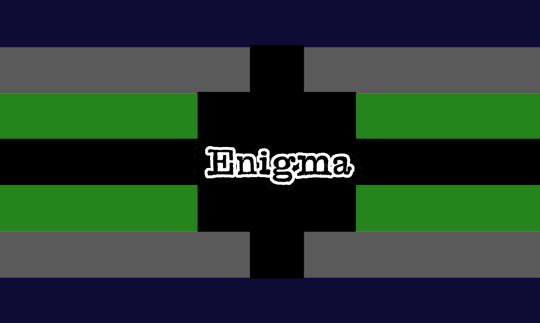
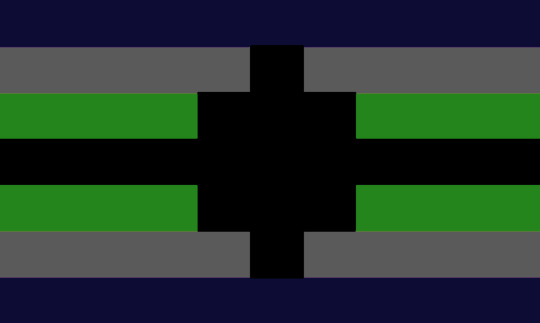
(1/29/23)
#enigmalexic#enigma#lexic#lexic gender#lexic system#lexic xenogender#xenogender#gender#nonbinary#kityenok genders
16 notes
·
View notes
Text

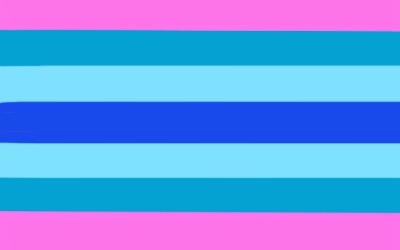
Femboylexic Coining & Flag
Femboylexic- A lexic gender related to the word femboy. When the word femboy is your gender.
Name comes from the word ‘femboy’ and the -lexic gender suffix meaning a gender related to a word.
Flag colors were picked by me and and the pattern is from other -lexic flags I’ve seen.
Coined by Me GenderpunkGenderhoard
#⋆⭒˚。⋆♕ƬӇƖƧ ƓЄƝƊЄƦ ƖƧ ƖƝ ƬӇЄ MƲԼƬƖƔЄƦƧЄ♕✧˖°.#˚✧ ₊˚ʚ𝓖𝓮𝓷𝓭𝓮𝓻 𝓑𝓸𝓾𝓽𝓲𝓺𝓾𝓮ɞ ˚₊ ✧ ゚#gender#gender coining#mogai#mogai blog#mogai coining#mogai community#mogai flag#mogai friendly#mogai gender#mogai safe#mogai term#pro mogai#genderlexic#lexic gender#xeno coining#xenogender#system friendly#🐇𝔇𝔬𝔴𝔫 𝔗𝔥𝔢 ℜ𝔞𝔟𝔟𝔦𝔱𝔥𝔬𝔩𝔢…#𖧧⟡Pყɳ’ʂ Oρυʂ𓍯𓂃
24 notes
·
View notes
Text
Lexicplex
[PT: Lexicplex]
Lexicplex, a plurplex term that means that a -lexic identity/being -lexic effects the entire system (or subsystem, layer, etc). It doesn’t have to be in the same way, it just has to affect everyone.
Lexic(link)



[ID: none yet]

[Tagging] @radiomogai, @plurplex-archive-dot-net, @pluralitywords, and @pluralterms

#✨⚫️✨ : post#Lexicplex#Lexic#-Lexic#silent fellowship#plurplex#the silent fellowship#sys#plural system#system#system term#system coining#plural#plural term#plural coining#gif#flashing gif
10 notes
·
View notes
Text
Hey!! A quick question for fellow systems with synesthesia,
Does it effect each of you in a different way? Like, do you all get something different from it, and do some experience it in a lessened degree or higher degree than others??
We have synesthesia, but we've never thought about this, and I obviously can't remember or know what the others in our system experience. We were going to try and document it within our own system, and probably still will, but I'm curious about others as well!! Reblog or comment your responses please, preferably a reblog for further reach! 🩵
#anti endo#anti endogenic#traumagenic only#actually did#complex dissociative disorder#dissociative identity disorder#did system#did sys#didosdd#osddid#cdd#cdd system#synesthesia#color synesthesia#taste synesthesia#scent synesthesia#projective synesthesia#associative synesthesia#grapheme color synesthesia#lexical gustatory synesthesia
35 notes
·
View notes
Text
Last Line Tag Game
Hey, been a while. Was recently tagged by @sunset-a-story , @mrbexwrites , and @maskedemerald for this tag game; and I'm certain others before them.
Rules: post the last sentence you wrote in your WIP and tag as many of your followers as there are words in the sentence.
Been away from interacting on tumblr for a hot minute; broke a writing hiatus last week; gonna ride out my desire to interact and write while it lasts! I'ma do two 'lines' from the most recent version of 'Flesh Town' since that's what I'm working on:
Worry, concern used to mask criticism of a lifestyle they didn't approve of. Save for Brutus, far as I could read he was genuine with his care.
"Found what you're looking for yet?" Brutus was already pouring a mug of the usual cheap wine I ordered. Bless Him.
soft tagging: @covenscribe @cee-grice @sam-glade @thatndginger @scribe-cas
During my break from writing I've picked up some coding with the desire to maybe churn out some small form video games, likely in one of my settings or inspired by my writing. Anyways; because it's punny here is the last line of code I wrote for Advent of Code:
const replaceLetters8 = replaceLetters7.map(el => el.replaceAll("nine", "9"));
The code still doesn't work 'correctly' but hey I've only been doing this for a month.
#writeblr#writers on tumblr#Flesh town#last line tag game#Oh and I'm somewhat back on lexical#not narratively but in the form that I'm putting effort towards actually fleshing out the ttrpg system#which I was pushed to do so by one of my players wanting “work on Lexical” for a Christmas present#Anyways thanks for keeping me in yours tags and asks even though I've been quiet#getting a ping from a mutual always brings joy to my day
10 notes
·
View notes
Text
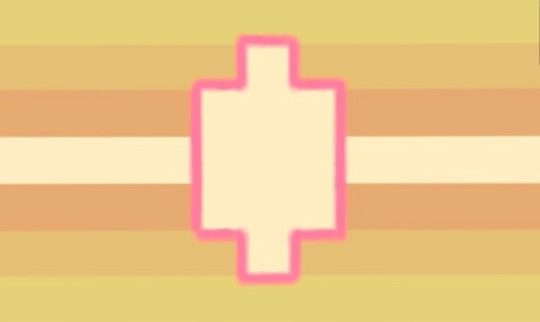


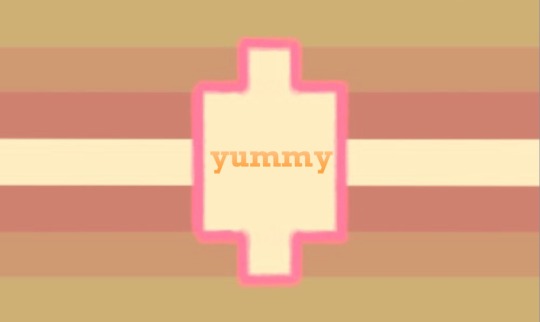
Yumlexic: a lexigender related to the word yum
Yummylexic: a lexigender related to the word yummy
Flags made using @/epikulupu’s lexegender flag template! Lexegender made by @/pupyzu


Yumbodiment: a gender under the genderbodiment umbrella that is the embodiment of the word yum and/or is the embodiment of being yum
Yummybodiment: a gender under the genderbodiment umbrella that is the embodiment of the word yummy and/or is the embodiment of yumminess
Flags made by using @/muutagenic’s genderbodiment flag template! Genderbodiment made by @/muutagenic


Yumstimmic: a gender related to the word yum being a vocal stim
The -stimmic suffix was made by @/pupzu
#pompom coins#🍯 coins#lexigender#lexic#lexic gender#lexegender#genderbodiment#genderbodiment system#mogai coining#xenogender coining#mogai flag#xenogender flag#gender coining#mogai gender#xenogender#pro xenogender#ids in alt#yumlexic#yummylexic#yumbodiment#yummybodiment#yumstimmic
10 notes
·
View notes
Text
ON BASQUE AND ITS TIES WITH GEORGIAN, ARMENIAN, AND TAMAZIGHT.
American linguist Morris Swadesh (1909-1967) created a world map of current languages according to comparative linguistics, taking into account their common origin. The lexico-statistical or glottochronological Swadesh method is based on taking 215 words in two groups of 100; key words such as personal pronouns, low numerals, parts of the body, kinship names, some action verbs, some adverbs of time and place, objects of nature, very common actions, bodily actions and questions.
Swadesh claimed that in the basic vocabulary the rate of change is so regular in languages, that he had been able to create a system of measuring the elapsed time in which two languages were related in the past and that today are separated geographically.
According to Swadesh, that basic vocabulary of 100 or 215 words changes less than 20% per millennium in each language. These variations in vocabulary leave a common ground between two or more languages related to each other, which is measured chronologically, thus establishing the time distance between a language and its more modern relatives. If the number of words with the same root between two languages in these two groups of 100 is less than or equal to 5%, it is considered a similarity by chance (the figure does not respond to anything specific, the method has many random parts), and if it is greater it would be the result of some common past.
There is a formula to know the time elapsed between the period in which the contact occurred and the current moment, and the result with Basque was the following (with the rest of the languages with which Basque has been compared by this method the result is inferior and not significant):
list 215 list 100
Northwest Circassian Caucasian:
6.62% 7.52%
Northwest Avar Caucasian:
3.80% 5.37%
Georgian, South Caucasian:
4.73% 7.52%
Rift Tamazight (northern Morocco):
6% 9.67%
Southern Tamazight (southern Morocco)
7.38% 10.86%
Many of the similarities considered good are more than questionable, since the evolution of words and languages is not taken into account, some borrowings from other languages are considered good, etc.
Nor can we forget American linguist R.L. Trask, that compared Hungarian and Basque and found in 2 hours of searching 65 similar words that could only be the result of chance, but that lead to question many investigations: this exercise tested by other researchers with other unrelated languages has given the same surprising result. R.L. Trask said “I can't understand why some linguists get so excited when they find two dozen Basque words that look like two dozen other Berber or Sumerian words.”
Basque and the languages of the Caucasus
The Caucasus is located 4,000 kilometers from Garonne-Pyrénées-Ebro where the Basques live. In the Caucasus, about 50 different peoples coexist with almost 22 languages. The main difficulty in establishing the Basque-Caucasian relationship consists of this lack of unity.
Swadesh's lexico-statistical ratio of Circassian and Georgian to Basque is 7.52%, higher than any other language in the world. The supposed contact would have occurred in the Magdalenian, about 10,000 years ago. With the rest of the languages of the Caucasus, current Basque is similar in typology (verbs, the ergative, etc.) and in the etymology of some words, but its lexical-statistical relationship with all of them is less than 5%.
There are also parallels between Basque and Georgian in syntactic aspects, such as the use of the ergative (transitive-intransitive verbs, “Nor-Nork” forms) that do not occur in any other European language, the reflexive way of making sentences such as: “I have seen my head in the mirror” (nire burua ispiluan ikusi dut), and not: “I have seen myself in the mirror”, the use of base twenty to count, etc.
But many current or recent renowned linguists are skeptical about the relationship with the Caucasian languages. Basque linguist Koldo Mitxelena (1915-1987) said that: “In summary, there are some Basque-Caucasian lexical similarities that cannot be demonstrated to be possible, but on the other hand there are a large number whose extraordinary implausibility can be demonstrated (…). Even if Basque and the Caucasian languages go back to a common origin, the number of missing intermediate links must be so high that it is to be feared that, due to not knowing them, the ancient ties of kinship will not be established."
If there is a relationship, for both Koldo Mitxelena and Xabier Kintana, it has to go back to the fifth and sixth millennia or earlier.
Basque and Armenian
Armenian linguist and Basque philologist Vahan Sarkisian, creator of the Basque-Armenian Dictionary and a Grammar of the Basque Language in his language, is the main promoter of the "Basque-Armenian theory" and the one who has done the most work in recent years on ethnolinguistic kinship between both peoples.
This prestigious Armenian linguist affirms that "the best promoters of this theory were neither Basques nor Armenians and, therefore, they had no direct interests in the issue. I am referring to the Englishman Edward Spencer Dodgson and the German Joseph Karst. The former knew well Basque. In Paris he began to study Armenian and quickly detected the similarities, which he initially summarized in a list of 50 words. Karst was an Armenianologist and, when he came into contact with Basque, he compared issues related to anthropology, the phonetic system, the grammar and the lexicon and extracted more than 400 similarities. (...) We understand without problems, for example, what Zabaltegi, or Ormazabal means, because it means exactly the same in Armenian. We feel at home, and that already means something. Armenian is considered an Indo-European language (Basque is the only pre-Indo-European language in all of Europe, prior to the invasions of these peoples), but if we bring to light the twenty most important regularities of the language we will see that they coincide more with Basque than with any other neighboring languages such as Georgian or Persian. And not only referring to the lexicon. In Armenian, for example, words are not formed with an initial -r, our throat has a hard time pronouncing it. The same thing happens to the Basque language, to the Basque throat.
Neither Armenian nor Basque recognize the accumulation of consonants, they are unpronounceable to us, while in other languages neighboring ours, such as Georgian, groups of up to five or six consonants are common. We could mention many other characteristics that separate us from our neighbors and bring us closer to Basque, such as the postponed article, the way of forming the plural, not to mention toponymy, which provides an enormous amount of similarities. (…) I believe that this type of coincidences - which even affect the articulation apparatus, which has a physiological nature - cannot arise from mere contact, they cannot be imported or exported. Karst said that Armenian and Basque are two varieties of the same linguistic stem (…) The only thing I would dare to say with any certainty is that perhaps in ancient times the entire area was occupied by the same ethnic-cultural element, which gave way terrain to other elements, leaving vestiges in Euskadi and Armenia, as survivors of a great and ancient civilization.”
It is curious that Armenian – which does not give any relationship with Basque through the Swadesh method – and Georgian are, apparently, more similar to Basque than to each other when they are neighboring peoples. To conclude this short summary, let's share a toponymic curiosity: in Georgia there is Mount Gorbeya (like the highest mountain in Bizkaia and Alaba), in Armenia is the sacred Mount Ararat (like the Aralar mountain range between Alaba, Gipuzkoa and Alta Navarra), and also a mountain named Gora (mountain in the language of the area and "up" in Basque). The curiosity is even greater because the Araxes River bathes Mount Aralar, and in the Armenian Mount Ararat there is a river called... Araxes.
Basque and Tamazight
Tamazight, by the Swadesh method, is not related to Arabic or Egyptian; nor with Georgian, but with Basque, as well as the Cadmitosemitic languages from which it comes. Therefore, Basque is a language that may have common elements with Georgian and Berber, but they do not have any with each other.
The percentage of lexical-statistical relationship of Swadesh of Basque with Southern Tamazight is 7.38% and with Rift Tamazight is 6% (taking the 215 words because with 100 the percentage increases). Therefore, by this method there would be a relationship or common substrate between both languages. Based on the percentage relationship, contact would have taken place about 8,000-9,000 years ago.
In Berber the names given to animals are very similar to those given in Basque. «Aker» & «iker» (billygoat), «asto» & «ezet» (donkey); They also coincide in the way of saying horse, crow, river, brother, lie, name ("Izen" and "isem"), "I" and others.
Within this analysis we must mention the Guanches, native inhabitants of the Canary Islands before the arrival of the Spaniards. From the writings found (archaeology confirms this) it is believed that the Guanches would speak a Tamazight language that, due to the isolation of the islands, would maintain a greater degree of relationship with Basque. There are those who even see Basque place names in the Canary Islands such as: Los Llanos de Aridane (Harrigane: stone peak), Argindei, Tinizara (Tinitzaha), Tajuia, Tenegia, Jedei (Iedegi) in La Palma and in Lanzarote: Masdeche (Mahats- etxe: grape-house), Haria, Orzola, Guinate (Gainate: high step), Yaiza (haitza: rock), Ajache, Tesegite, Mozaza etc.
An anecdote that is often told is that the first conquerors of the Canary Islands believed that the natives spoke Basque.
Between Basque and Tamazight the similarities are reduced to the lexical or lexicographic level, since syntactically and grammatically there does not seem to be any relationship, both in current speech and in the past; there are just similarities in verbal articulation or in the use of some particles.
Julio Caro Baroja said in this regard: “I must warn in any case that the relationship between Basque and the African languages called Hamitic is not as founded as claimed. On the contrary, the hypothesis of a relationship between Basque and the Caucasian languages, which is perhaps the one that has produced the least interest in the Peninsula, seems to be the most prudent, because it is based on linguistic, morphological and strict observations.
Koldo Mitxelena had the same opinion, and believed it was necessary to study more the relationship between Basque and the Caucasian languages which, unlike the supposed kinship with Tamazight, did cause serious doubts.
[x]
@knario47
#euskal herria#basque country#pays basque#pais vasco#euskadi#linguistics#euskera#euskara#basque#language#armenian#georgian#tamazight
92 notes
·
View notes
Text
I have a lot of thoughts about epistemology and the nature of procedural knowledge. Studying linguistics really impresses upon you just the sheer amount of human knowledge that is procedural and implicit. Languages are these huge, ridiculously complex systems, and even when it comes to the most thoroughly documented language in human history (English), you can still make an entire career documenting as-yet-unknown minutiae of some corner of a corner of the system. It's very difficult to impress upon non-linguists just how big and ill-understood languages are.
There is no book which explains the whole of English grammar. No one on earth knows the complete rule-set of English grammar. Not even for one dialect, not even for one single speaker. No one on earth could write a comprehensive treatise on English pronunciation. We do not know how English works. We do not know how any language works.
And yet, these systems are, in their entirety, already stored in the mind of every native speaker.
When it comes to synchronic information, I literally already know everything there is to know about my dialect of English. I know the timing of every articulation, the exact rules for verb and auxiliary and quantifier placement, the phonology, semantics, syntax, the lexical variation, the registers, all of it. I can deploy it effortlessly while I am thinking about something else. I can form reams of perfectly grammatical English sentences without a second thought. I can deploy the most arcane rules of wh-movement and quantifier raising and whatever else. With no effort at all.
Tens of thousands of people having been making careers trying to document these things, not for my exact dialect but for varieties essentially the same as mine, for 60 years in earnest. And they aren't close to done. And I already know it all. And so do they! They already know it too! The hard part is accessing it, putting it down on paper. That requires experimentation, systematic empirical investigation—science.
So what this has really impressed on me is how much of human knowledge is procedural. How much of it is known only in the doing. I'd wager that's the significant majority of what we know.
This is related to two thoughts that I have.
The first is about the value of unbroken lines of cultural inheritance. With language, the difference between native speakers and second language learners is stark. I think it's safe to say, per current research, that someone who learns a language in adulthood will simply never have the same command of it as someone who learned it in childhood. There are a variety of tests which consistently distinguish native from non-native speakers. You can get very good at a language as an adult learner, good enough for basically all practical needs (except being a spy), but there's a bar your brain just cannot meet.
The unfortunate fact about language is this: if the line of native-speaker-to-child transmission is ever broken, that language is lost. You can try to revive... something, if you want. Like was done with Hebrew in Israel. But it will not be the same language. And not just in the sense that, by the passing of time, all languages inherently change. In a much stronger sense than that. No matter how big a text corpus you have, no matter how well documented the language is, there is an immense body of implicit, undocumented, procedural knowledge that dies when the last native speaker does. And you cannot ever get it back.
I think, often, about the fact that so much human knowledge is procedural, is used and understood and passed on in illegible, difficult to codify ways. I think about the effect that a rapidly changing world has on this body of knowledge. Is it going to be essential for human prosperity? Probably not. But that doesn't mean that losing it will harmless. Certainly I expect much of it to be missed.
The second thought is about an epistemic distinction that I've had in my head for a long time, a distinction I'd like to refer to as that between a science and an art.
An art is any endeavor for which there is an established methodology, an established set of procedures and rules. These rules can be explicit and codified, like the rules of a game, or implicit, like the grammar of a language. They can be absolute or they can be mere guidelines. But in essence, an art is anything you can get good at. Math is quintessentially an art. Football is an art. Ballet is an art. Painting is an art. An art is any endeavor in which procedural knowledge is acquired and channeled and refined and passed on.
Art contrasts with science. A science is any endeavor in which one is shooting blind. Science is the domain of guesswork and trial-and-error. Sciences are those domains that do not lend themself to practice, because... what would you practice at? You cannot get better at science, because science is not about skill. Science is about exploration. It necessarily involves forging your own path, working with odd and faulty tools and odd and faulty ideas, trying to get them to work. Science only exists at the frontiers; when a path is well-tread enough that a body of procedure becomes known and practiced, that path is now art and no longer science.
This distinction is not a taxonomy. Everything we do involves a little bit of art and a little bit of science. Everything involves both a refinement of known skills and an exploration of new avenues. Of course there's a little bit of science in painting, there's quite a lot of science in painting. Every modern and contemporary art museum is full of it! And there's science in math, every once in a while. And there's art in biology and chemistry. Art and science are two modes of engagement, and different endeavors demand them of you in different ways.
Perhaps science is like a glider (you know, from Conway's game of life?), traveling ever outward, and with enough passes over the same area leaving art in its wake. And I think in some sense that all real human knowledge exists as art, that all endeavors capable of producing true insight are either arts or sciences buttressed by a great many supporting arts. Although maybe I'm wrong about this.
I think history is mostly science, and in large part history as a field seems to be on quite solid epistemic footing. So I don't want to convey the idea that science is inherently dubious; clearly from the above description that can't be my position. Nor is art inherently trustworthy—for instance I think jurisprudence is primarily an art, including religious jurisprudence, which of course I don't place any stock in. But I do think I'm getting at something with the idea that there are a range of epistemic benefits to working within an art that one lacks access to in a totally unconstrained science. This is also closely related to my ideas about abstraction and concretization schemes.
Language is an art, one of the oldest arts, but modern linguistics is more or less a science. Like any good science, linguistics has certain arts unique to itself—fieldwork and the comparative method come to mind—but the most vibrant parts of the field at present are science through-and-through. It's a science whose objects of study are arts, and I think maybe that's part of why I've become so aware of this distinction. Or, language is the ur-example of an art, the art from which (if I were to conjecture wildly) I think the cognitive machinery for very many other arts has been borrowed. But I don't really know.
Anyway, those are my thoughts.
215 notes
·
View notes
Note
What is the sapir whorf hypothesis?
The Sapir-Whorf hypothesis is the idea that language dictates thought. In the strongest sense of this hypothesis, if you don’t have the vocabulary for a concept, that concept doesn’t exist to you.
This is pretty controversial in the field of linguistics. Many agree with the concept of linguistic relativity, or the idea that language can influence the way people interact with the world. For example, different languages have different systems of words for sorting colors. In English, green and blue are considered two different colors, while several languages, like Zulu and Xhosa, don’t distinguish between the two and instead have a single word that encompasses both hues (sometimes referred to as “grue” by English-speaking linguists). On the other hand, English speakers consider dark blue and light blue to be different shades of the same color, while Mongolian has two separate words for them. Some languages, like Pirahã, only lexically distinguish between light colors and dark colors.
In other words, if you gave people from different places a bunch of paint chips and told them to sort them all by color, you might find some interesting differences in the results. But just because they’re categorized differently doesn’t mean the colors necessarily look different to different speakers. Most English speakers with normal vision can still tell the difference between light blue and dark blue even if we don’t have distinct terms for them, just like a speaker of a language without blue/green distinction can discriminate between the color of the sky and the color of grass.
The idea that language determines your thoughts (linguistic determinism) also leads down a very slippery slope, often with racist connotations. (Linguistics as a field has quite a long history of racist ideology, unfortunately.) The most famous example of this is Whorf’s conclusion that the Hopi Native Americans have no concept of time because the Hopi language does not have grammatical tense. In reality, there are other structures in this language that Hopi speakers utilize in order to just as effectively convey the past, present, and future as languages that do so with grammatical tense. On the flip side, English does not have a grammatical gender noun class system like Spanish or French does, but no one is trying to argue that English speakers don’t have a concept of gender!
My linguistics professors in undergrad really emphasized how flawed this hypothesis is, despite how convincing it can sound on the surface, and it has stuck with me and my classmates ever since. A few years ago, I was hanging out with some friends from college, and the only friend in the group who didn’t take at least one ling class mentioned something about reading “a really cool article about how language affects the way you think!” I can still hear the collective groan of everyone else in the room when he said that, followed by all of us scrambling to explain the issues and nuances of that claim 😂
98 notes
·
View notes
Note
I read your reply on Darys being the normative term in high valyrian and Daria being added for westerosi assimilation. Does this mean that high valyrian was a gender neutral language (in terms of male and female) and, if that’s the case, how did that impact gender relations?
Best wishes
This question isn't quite framed correctly. Viewed one way, the answer is no. Viewed another way, the answer is still no. However, neither of those answers is actually relevant. Let me explain.
High Valyrian has had grammatical gender from the early days (before the Old Valyrian stage, which is the stage before the main timeframe of the language). It still has grammatical gender. The gender system is absolutely foundational to using or understanding the language. The genders don't have anything to do with sex (indeed, the words for "man", "woman", "boy", "girl", and many others are all in the same gender).
But if you meant "Does Valyrian not distinguish between men and women", it does. I don't think we've yet encountered a language that doesn't. Finnish makes no sex or gender distinction in its third person pronouns and never has, but that doesn't mean it doesn't have words for man (mies) and woman (nainen). It just means neither grammatical gender, perceived/performed gender, or biological sex are grammatically relevant. High Valyrian has words for man (vala) and woman (ābra). It absolutely distinguishes the two lexically; it's just not relevant to the grammar.
Just because it does, though, doesn't mean it does so everywhere. Goodness, think of English! We have man and woman, of course. We also have actor and actress. But does that mean we have skydiver and skydiveress? Awardee and awardette? Officer and officerella? No. That would be absurd. Even a distinction like actor/actress is falling by the wayside as it's unnecessary and many don't want to make the distinction. Even basic terms like teacher aren't gendered. Now I want you to imagine you're coming from Spanish which has maestro and maestra for "teacher". Then you see that English just has the genderless word teacher! Would that lead you to believe that English is a "gender-neutral" language?
Valyrian didn't happen to make a gender distinction for a monarchical ruler. That doesn't really mean anything, though, just as not having separate masculine and feminine words for teacher means nothing in English. It's just a fact of the language. So to answer your second question, how did this language fact impact gender relations, not at all. To the extent that language and culture interact, it is language that reflects culture; it does not constrain or create it.
I hope that helps to explain it a bit better. There are a number of myths that exist about the "power" that language has to "control" the brain and society at large. These myths have their place, and it is in the pages of science-fiction and fantasy. Language is our tool: we create it, shape it, and wield it. But in terms of using it to chain the brain, it's a bit like tying someone up with Kleenex: You probably can, but it won't hold.
44 notes
·
View notes
Text
Welcome to me being annoyed I can’t find overall flags for gender systems/-suffixes so I made my own.
-Songic
[PT: -Songic]
Songic terms are commonly genders relating to individual songs. So this flag is meant to represent the overall idea of genders relating to songs/represent songic terms!
Template(link)


-Lexic
[PT: -Lexic]
Lexic terms are commonly used for single word genders such as genders relating to the word “cat”, or “love”, etc. so this flag is meant to represent those type of terms!
Template(link)


[Tagging] @radiomogai, @liom-archive, and @accessmogai
[Templates made by] @revenant-coining

#📝 : post#💛 : flag reimaging#🌼 : gender terms#mogai#mogai term#mogai coining#liom#liom term#liom coining#xenogender#neogender#xenogender term#neogender term#lexic#lexic term#songic#songic term
56 notes
·
View notes
Text
introducing - our tonsi flag ( len sitelen pi kulupu tonsi ! ) 'tonsi' is a toki pona word that, roughly, means "a gender experience not fully described by 'mije' [man] or 'meli' [woman]." context + design explanation under the cut 🌈❤️

🗣❗️ : toki pona is a minimalist conlang, which this post assumes very basic knowledge of. if youd like, u can read the wikipedia page (linked above), or this article from the atlantic, "Toki Pona: A Language With a Hundred Words."
some background on the creation of 'tonsi' - toki pona started development around 2001, and was 1st published in 2014, with 120 "canon" words - including the 2 gender words, meli & mije. however , toki pona is a living language, + words come about as the community needs them - the community came together to create 'tonsi' in a grassroots effort c. 2019 to fill a lexical gap that existed for describing ppl who fell outside the meli-mije duality.
etomologically, the word is from mandarin 同志 'tóngzhì' (meaning "comrade", & commonly used to mean gay / LGBTQ - though "tonsi" itself is generally agreed refer to gender.) some people use it exclusively to mean "nonbinary / genderqueer" , but expanded usage to also include all trans & gnc people (who choose to identify as tonsi) is very common, + is a definition i endorse ( & created the flag in mind with ! ) the word was officialized as an essential word in 2021 w./ the release of the toki pona dictionary
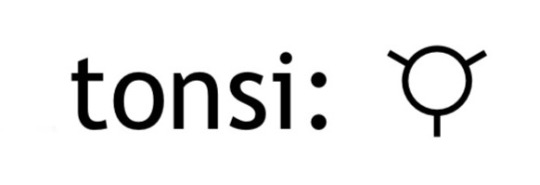
the sitelen pona ( logographic / hieroglyph writing system ) glyph for 'tonsi'
as for the design & symbolism of the flag - the central blue symbol represents the sitelen pona glyph for tonsi (shown above), in the blue of the toki pona logo - the 3 segments (colored pink, green, and purple) were roughly inspired by colors on the trans, gq, & nonbinary flags - as a whole, the flag symbolizes the way the tonsi community unites people of all different gender experiences & primary-language terms.
toki pona philosophy is all about capturing universal concepts in a way that allows for clear and simple communication, and gender variance is absolutely a universal concept. tonsi is a beautiful + necessary word, & with this flag, i wanted 2 focus not on granular inclusions of which groups fall under tonsi , but rather the unity the term presents, and how it allows us to unite by what we have in common , rather than pick over the terminology we choose.

a version of the tonsi flag made in a 16:9 aspect ratio 4 convenience
to my knowledge, no one else has made an effort 2 create a dedicated tonsi flag, but reception to having one has been positive thru the toki pona speakers ive shown the design - much thnx to the people on discord who gave their thoughts, as well as @epikulupu for consulting - sina ale li epiku mute a ❤️ ( ill also be posting a lili version of this post on r/tokipona soon + will add a link when i do 🌈 )
im passionate about toki pona + its community, + am an advanced speaker myself - if you have questions / comments , dm me, send an ask, or leave a reply - id always love 2 chat in/about toki pona 😁 if u.r interested in learning, i reccomend using this free course (lipu sona pona) & joining the discord , ma pona pi toki pona. as always, my flags are free to use, w./ credit appreciated but not required - stay pona ❤️
260 notes
·
View notes
Text
The Erelian Script has a very long history, stemming back thousands of years and across many cultures and another planet. There are eight notable stages of the development of Erelian writing that I'll go into detail about, as each stage marks a sharp change in the regular use of the script, as opposed to more gradual changes over time.

This is the development path for the Erelian letter A, which is pronounced as /ɑ/. It's one of the letters who's pronunciation has remained relatively consistent throughout time.

Pre-Proto-Seraphic Glyphs
The first glyphs recognized to carry semantic content. These first glyphs were ideograms, used mostly for labeling, inventory, religious rites, supernatural charms, and other simpler uses. They would've been etched into stone or painted using dyes made of local plants or animal blood. This glyph specifically would've conveyed the meaning of "all" or "whole", depicting a jar or cauldron with a lid on top.

Old Proto-Seraphic Bark Etchings
As writing was developing more, and glyphs becoming more complicated, the glyphs began to drift away from ideograms and logograms and make use of more phonetic elements. This glyph was used for the word "whole", but also represented the glottal stop /ʔ/ when used phonetically. Proto-Seraphic writing began to be written on the dried bark of paper tree, etched into the bark and dyed by way of similar tanning processes used for animal hides. This paper was more fragile than stone, but much easier to replace and less time-consuming. As it went into regular use, the seraphim found it inconvenient to hold the very long strips of paper in the usual horizontal fashion, reading right-to-left and top-to-bottom in reverse boustrophedon and constantly turning it on its side when writing, so they began to read it at a perpendicular angle going from right-to-left to bottom-to-top

Proto-Seraphic Writing
At some point, the Proto-Seraphic culture migrated from further in the continent towards a vast group of islands and coasts. Since they did not regularly practice agriculture, and paper trees did not produce seeds, they could not bring their original writing commodity with them. Thus they began using a thing stylus called a hwituyáw to make impressions into wet clay, which they would then either let dry or bake to make more permanent. The writing system changed in the following millenia to accommodate this, largely abandoning logograms and maintaining a majorly phonetic system, with a few exceptions remaining for lexical use. As Proto-Seraphic culture grew and advanced, and trade with foreign powers became more necessary, writing became a much more prevalent thing in society. A majority of late Proto-Seraphic writing comes from this period in history on surviving tablets, inscriptions on buildings, and earthenware. This glyph took on the role of the glottal stop /ʔ/, as well as the vowel /ɑ/.

Old Seraphic Writing
With the large amount of influence Seraphic culture took from surrounding cultures, they soon gained access to brush and pulp paper, and use of it was considered a symbol of the elite. At this point, the writing started to become much more fluid and rounded, and many stylistic variants are produced. The Soverign Conquest contributes to the spread of Seraphic language and culture across much of the world, and many languages adopt the Seraphic alphabet. At this point, Proto-Seraphic transitions into Old Seraphic.

Ealry Aeonic Seraphic Alphabet
This variety stems from the early industrial revolution. Brushwork largely falls out of use in favor of pigment and ink sticks, similar to pencils and pens. The forms become much more rounded and simplified, and variants begin to standardize to this form. As literacy becomes more prevalent in Seraphic society, and more and more people are expected to be literate, the writing system undergoes several spelling reforms, introducing things such as diacritics.

Aeonic Seraphic Alphabet
During the technological revolution, as Seraphic transitions fully into Aeonic Seraphic, the letters become fully standardized. Aeonic Seraphic becomes the lingua franca for much of the Homeworld, and these forms remain consistent throughout much of the Celestial Revolution which marks the seraph race's beginnings as an interplanetary species. Aeonic Seraphic is carried over as a continuing lingua franca to their first planetary colony; Erel.
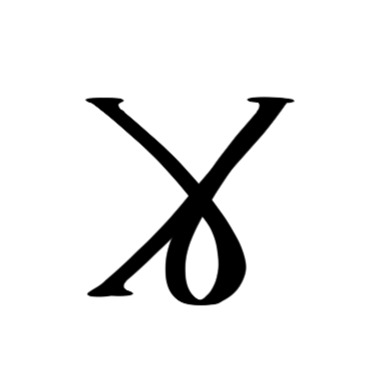
Old Erelian Alphabet
Due to Erel's population being largely separate from the Homeworld, the language naturally begins to shift into its own dialect, and eventually language. As the Collective adopts the Collective Seraphic script, Erelian continues to use the native Aeonic Seraphic script which develops further and further as the Erelian culture and identity becomes more solid. The shape becomes less round and more linear to match the aesthetic of the Collective Seraphic Script.

Modern Erelian Alphabet
The alphabet finally takes its final form, becoming much more linear and simplified to accomodate smaller text sizes. Many other newer languages and dialects will adopt either the Collective Seraphic script or the Erelian script to accommodate them.
11 notes
·
View notes
Note
heyy Scribe, happy last STS of the year!! it's hard coming up with an original end-of-year ask, so I'm just gonna shoot off a bunch of questions, and you feel free to answer whichever you want/haven't already:D
are you satisfied with where you're at right now in your writing journey? where do you hope to be at this time next year? do you have any Must-Accomplish 2024 writing goals? anything new you'd like to try in your writing (technique-wise, story-wise, scheduling-wise, structure-wise, etc.) next year? any stories you'd like to start? end?
Always happy to get an ask from you!
To be honest I'm not satisfied; I still find myself struggling to ever actually get words to page outside of 3am bouts of inspiration. Which I am working on! (well, have been working on). Figured out that I really need a "space" dedicated to writing rather than just sitting at my PC; but I've been dragging my feet on actually making a comfortable new space for that. Some room re-arranging may help in the near future.
I intend to finish at least two things in 2024: "fleshtown"'s rough draft, how ever long that turns into, and the Lexical System. Thankfully the bones of Lexical are already mostly thought out and even written down, I now just need to write up the meat of the mechanics and figure out how to explain the setting without writing a several hundred page document on the subject.
#writeblr#writers on tumblr#STS#Also#With the finishing of the Lexical System I will be able to start back up and finish the TTRPG campaign of it I've been running#Which I imagine will end up as reference material for if I properly put a rulebook together
1 note
·
View note
Note
am i the only one who thinks cancel culture has gone a bit too far? like we’re literally “canceling” people for the stupidest shit these days, and let’s be honest, most of us do these things in private as well. tell me you’ve NEVER made like a lgbtq+ joke (obviously not a full on offensive one) if a cc even made a harmless joke they’d full on canceled and harassed
IM NOT AIMING THIS AT U, i just rlly wanted to state my opinion on this 😭 i just don’t think it’s fair how we also judge some cc’s but not all. its different if they said some shit like “kill the (blank)” but for example (a stupid one, i know, but it’s 3 am and i can’t think properly) the internet cancelled charli d’amelio because she said ‘she couldn’t wait to hit a 100 mil because even numbers’ and that she wouldn’t eat a snail … bruva
No because I agree with quite a bit of this post, bc:
Cancel culture is unnecessarily didactic and entitled sometimes.
It's really weird how as an audience, people try to tell others that what they do is wrong, and that they should correct their actions. Because who the fuck has the rights to make the rules of what is wrong and right within society?
I think cancel culture is valid when it's consistent with laws - yk - getting people like child groomers called out and removed from platforms because that's plain fucking illegal. The law system is a great place to base your morals off of (from my limited knowledge of laws), but then again...
If a CC has committed a crime, is just removing their platform the best thing to do?
Sure, alerting their following a person is bad is a great place to start. Yk, reduce their following at their supporting because they're a straight WRONG'UN... but then what? We just let them live their normal ass lives after committing a crime? When the hell does police step in and sort it out?
Cancel culture is good at alerting the audience of a person's wrongdoings if illegal, but at that point, serious investigation and police intervention is probably also worth a shot.
But cancel culture is also really fucking harmful.
Obviously, rate of cancellation is very different online. Certain fandoms have different rates of cancellability, and boundaries with what CCs say. Need it in graphical form? Say less.
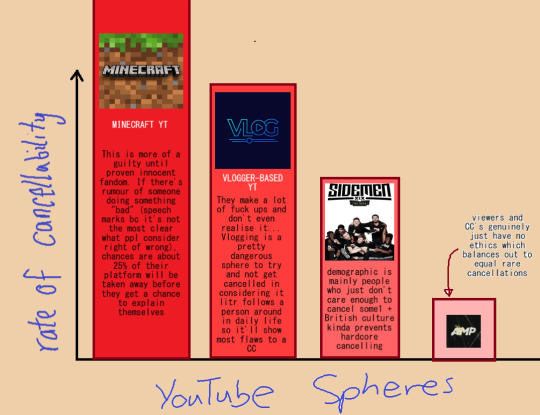
(No data backing this up, quite opinion and personal experience based so err... maybe take w a pinch of salt)
But there's places like AMP and Sidemen whereby they do A LOT of more morally gray things (objectify women, mild-casual homo and transphobia...)
And then there's placed like the MC fandom which need to take the fucking chill pill and slow it down. I mean, I remember this from my MCYT days:
"I get lesbians", said TommyInnit, "get" meaning understand (of course) - which didn't seem like a big deal to me. It empathised w women thinking men were a bit ew and unpreferable, and sure, it's a bit demeaning to men in a way whereby there's a bit "men < women" stereotype, but I don't think that's very harmful in an already patriarchal society.
but regardless, the fans were pretty fkn pissed because they interpreted what he said to mean that he... got with lesbians... And when someone explained to them that he meant "get" as in "understand" - you know, he's not a raging misogynist, self-proclaimed lesbian-undoing womanizer - did they back down and admit there was a misinterpretation within communication?
Nope!
Instead they tried to prove that he was still in the wrong because that was a poor word choice and he should've just said "understand" instead, if that's what he really meant.
They literally tried to 'cancel' him, for a lexical choice.
So in times like that, I remember that cancel culture isn't a wonderful thing - and the Charli D'amelio reference you give is just as valid tbh, anon.
Charli's cancellation + hate, I would love to talk about, but considering this is already a stupidly long n waffle-y post, I think I'll save it for next time.
Overall conclusions + take-aways:
-Cancel culture is good at taking platforms away from genuinely bad ppl
-But who are we to try and push our own morals onto a Content Creator? Ignorance is bad and should be corrected but often-times this didactic role which viewers take on is also just plain entitled
-I think it's better to point out flaws and present them to the audience + CC to hear them out, rather than viciously aiming to remove a platform and enforce views onto others
-Some places need a lot less cancel culture bc it's just not needed - some places need a lot more maturity to understand why what a CC does isn't morally great
-Lots of generalised sweeping statements made here - feel free to argue them j don't come at my neck ab them
peace n love as always
#WAFFLE!!#cancel culture#youtube#youtubers#youtuber#sidemen#amp#mcyt#minecraft#minecraft community#online community#vlogger#im just sorry in general this was a very long + lowkey badly explained post
10 notes
·
View notes